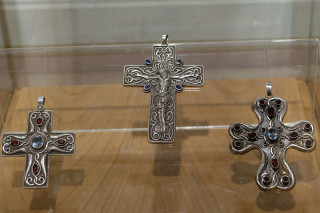
The relationship between the Hungarian Catholic Church and culture dates back all the way to the foundation of the Hungarian State. Though Géza, father of Saint Stephen, King of Hungary, started the introduction of monastic orders in Hungary, it was his son, the first king of Hungary, who developed and strengthened the system of the Church’s institutions. King Stephen I was committed to Western European Christianity and requested the pope to provide him with a crown to sanctify his coronation. Not only did this grant legitimacy to his position in the Christian world, it also laid the foundation for Hungarian culture.
The monastic orders that pursued their activities in Hungary during his reign played an important part both in spreading the Christian faith and religion and in introducing Western European cultural values. Representatives of the Catholic Church were tasked with creating a written form of the language using the Latin alphabet and establishing institutions of education and culture. The monasteries of monastic orders became centers for writing codices and their libraries were home to collections of written culture. In addition to creating a literary culture, they also played an important role in spreading the Roman and Gothic styles of medieval architecture and Gregorian chants. The Hungarian Catholic Church of the Middle Ages put Hungary on the path of modern cultural development, linking society to Europe’s Catholic communities.
The Church also played a pivotal part in preserving religious faith and culture during the Middle Ages. During the Renaissance, secular song grew in popularity alongside ecclesiastical music. A peculiar feature of Hungarian history is that the spread of Renaissance culture in the name of secular values is also linked to the Catholic Church. Janus Pannonius, Bishop of Pécs, was the most important Hungarian Renaissance poet.
During the time of the reformation, the Catholic Church’s influence in religious and cultural life decreased. By establishing a university in today’s Trnava, Péter Pázmány achieved resounding success in developing Hungarian education and culture. His sermons are great examples of Hungarian Baroque literature. Similarly important is the Rococo poetry of another Jesuit, Ferenc Faludi, written almost a century later, which contributed to renewing Hungarian verse.
During the Age of Enlightenment in the 18th century, the Catholic Church’s role in spreading culture lost much of its importance. Although the anti-religious rhetoric of the age curbed the Church’s cultural influence, it maintained control of education: the majority of schools were still run or maintained by the Church. This situation prevailed up until the middle of the 20th century.
In the post-World War II socialist system, the Hungarian Catholic Church lost even the possibility of spreading its culture through schools. As education was placed under the control of the communist state, the protection of Christian beliefs and culture became the prerogative of the small number of remaining ecclesiastical schools.
The elements of secular, modern art first appear in the Church’s architectural language in the first half of the 20th century. This is also an important period of Hungarian Catholic literature. The establishing of the Vigil Society led to authors such as Sándor Sík and György Rónai representing the Catholic faith and Church.
After the change in political system, the Hungarian Catholic Church again gained the possibility of supporting the interests of Catholic religion and culture in both education and the arts. Today, Church-run schools, Pázmány Péter Catholic University, and monastic orders play an important role in preserving and developing Catholic values.